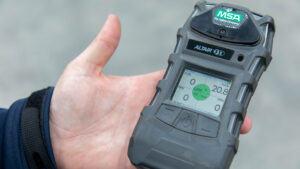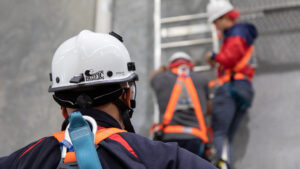One important aspect of having safe work practices is making sure your safety equipment stays in good working order. A harness, for example, should be checked before every use. Here is what to look for.
Before starting work using a fall protection or safe access system, it is vitally important that a worker make sure their equipment is in good working order.
It is always worth taking a moment or two in order to stop and make sure that everything is OK before going up on a roof.
For workers at heights, one of their most important pieces of PPE is their harness. In situations where there is a fall risk the harness is not only the means through which the worker is connected to the safety system, in the event of a fall it also works to protect the worker from the impact of the system catching and stopping the fall.
But what do you need to look for? Here are six things that every worker should check before they put on their harness.
1. Is my harness clean?
If your harness is covered in dirt, oil or other substances, this could be an indication that the webbing material is degraded or damaged. Make sure your harness is clean of any foreign material.
2. Check the webbing for damage
Webbing that is cut, torn, frayed or worn can be dangerous. In the event of a fall, these points could fail and the worker runs the risk of the harness not staying fitted correctly.
3. Check the harness stitching for damage
Like webbing, stitching that is damaged or coming undone places a worker at extreme risk of injury in the event of a fall. Make sure all stitching is intact, clean and not becoming unwoven.
4. Check D-rings for damage or corrosion
Metallic D-rings can be susceptible to corrosion like many other metals. As these rings are the main load-bearing component of a harness, it is important they are in good working order. Deformed or damaged D-rings can also indicate a fall occurred while the harness was being worn. In that case, it should be removed from service immediately and replaced.
5. Check the harness buckles and adjustments points work freely
Buckles should work correctly and easily. Check they are not cracked or damaged. Adjustment points are vital for ensuring the worker can correctly and comfortably fit the harness to their body. These should also be free from foreign objects so they close fully and remain locked in place.
6. Does anything look odd or out of place?
Finally, a quick look to see if there is anything about the harness that looks like it does not belong or has changed since it was last worn can catch uncommon or unobvious issues.
What about the six-monthly PPE inspections?
All PPE items should be inspected by a competent person every six months. These inspections are more thorough than a pre-use check and cover off items like ensuring standards and compliance labels are present, and the harness has not reached its designated end of life.
They also take a more detailed look at the physical state of the harness, spotting any maintenance issues that may need to be addressed.
I still have questions about harnesses and PPE
Height Safety Engineers have written a short guide on what to look for when choosing a harness. Our expert team is also on hand to answer any questions you may have and to help you solve your safety problems. Call us on 1300 884 978 or email enquiries@heightsafety.net.





